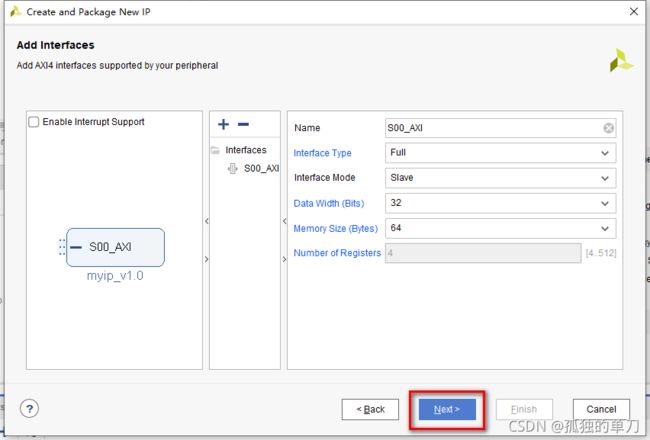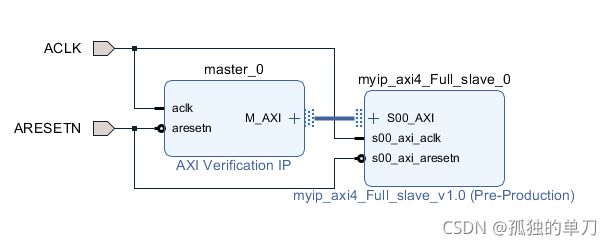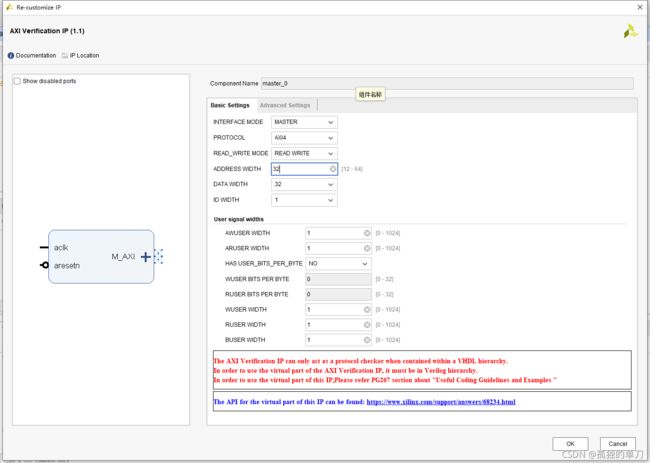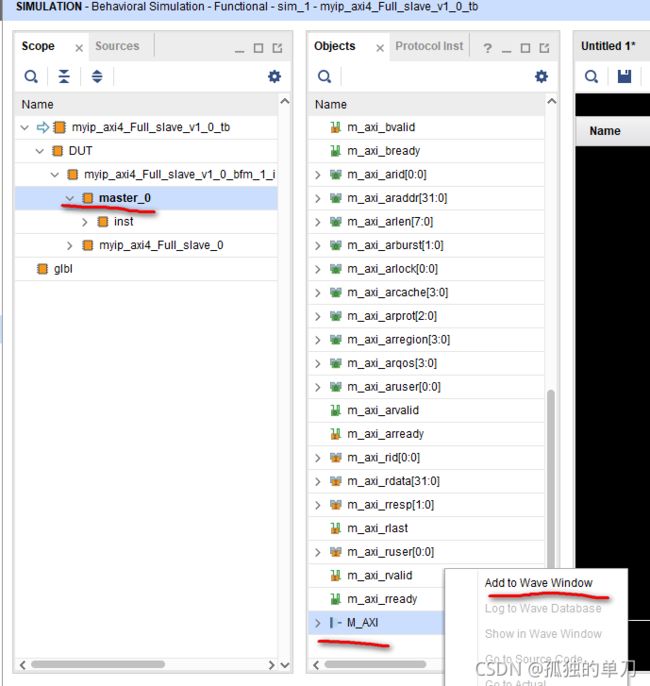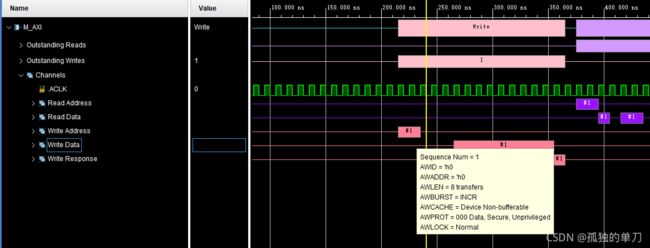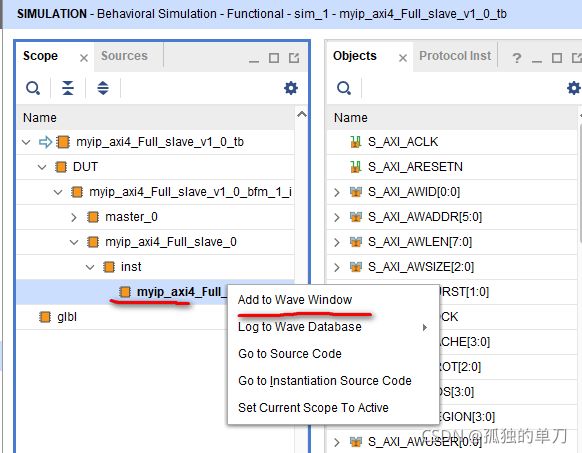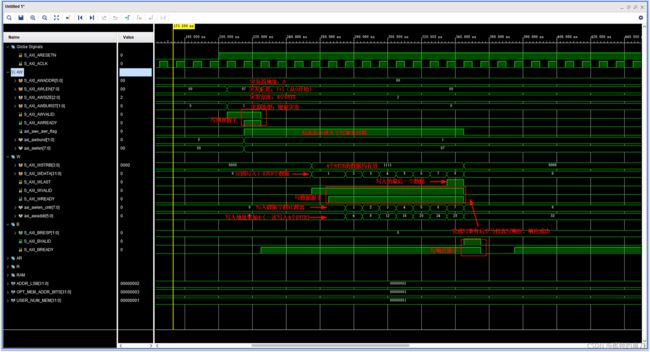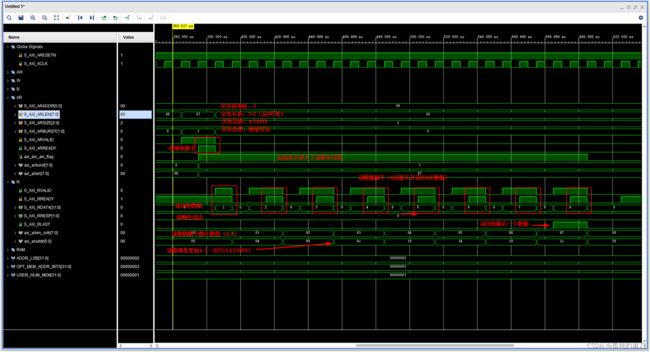带你快速入门AXI4总线--AXI4-Full篇(2)----XILINX AXI4-Full接口IP源码仿真分析(Slave接口)
写在前面
打包2个AXI4-Full接口的IP(一主一从),来对其提供的仿真和原始代码学习一番。限于篇幅,将分2篇文章写完,本文写AXI4-Full接口。AXI4-Full接口的源码基本与AXI4-Lite接口的源码一致,不过多了突发传输控制的相关信号,建议配合AXI4-Lite接口源码分析文章一并查看,有助于理解。
带你快速入门AXI4总线--汇总篇(直达链接)https://wuzhikai.blog.csdn.net/article/details/121574746![]() https://wuzhikai.blog.csdn.net/article/details/121574746
https://wuzhikai.blog.csdn.net/article/details/121574746
1、调用IP
首先新建一个工程,然后点击Tools-----create and package new ip
![]()
点击Next
![]()
选择选项4,点击Next,各选项含义:
- 1---将当前工程打包为IP核
- 2----将当前工程的模块设计打包为IP核
- 3----将一个特定的文件夹目录打包为IP核
- 4----创建一个带AXI接口的IP核
![]()
填写IP信息(基本不修改,只改下名称方便后续管理),点击Next
选择Full接口,接口类型选择从机slave,数据位宽32位,存储器大小选择64即可,然后点击Next
这里选择第3个,使用AXI4 VIP来验证IP,然后点击Next。(AXI4 VIP是XILINX的一个IP核,该IP核可以提供多种连接方式来对AXI接口进行验证,用起来很是贴心方便,我们后面会写相关文章,还请期待。)
![]()
到此就生成了一个slave接口的验证工程。不着急仿真,先跟它耍耍。整个工程的结构如下:
双击上个表示的BD模块,打开工程框图,如下:
整个工程由两部分构成:1、我们打包的IP,该IP的接口是AIX4-Full-slave;2、AXI Verification IP,这是一个AXI的验证IP,提供多种验证方式,功能很强大,双击这个IP,看看它的内置定制信息:
可以看到,它可选选择接口模式来实现主机或从机或直通功能;可选协议类型,地址位宽,数据位宽等。我们这里不动它,直接cancel。
2、Slave接口的源码分析
在如下路径下有生成的接口源码:
接下来双击打开,我们一探究竟。(由于源码较长700行,一次性展开不利于阅读,我接下来分块进行讲解)
NO.1----模块参数、输入输出信号:
参数主要是数据、地址、ID的位宽;
接口即为标准的AXI4-Full的标准接口,忘记了信号定义的可以看这里:带你快速入门AXI4总线--AXI4-Full篇(1)----AXI4-Full总线
`timescale 1 ns / 1 ps
module myip_axi4_Full_slave_v1_0_S00_AXI #
(
// Users to add parameters here
// User parameters ends
// Do not modify the parameters beyond this line
// Width of ID for for write address, write data, read address and read data
parameter integer C_S_AXI_ID_WIDTH = 1,
// Width of S_AXI data bus
parameter integer C_S_AXI_DATA_WIDTH = 32,
// Width of S_AXI address bus
parameter integer C_S_AXI_ADDR_WIDTH = 6,
// Width of optional user defined signal in write address channel
parameter integer C_S_AXI_AWUSER_WIDTH = 0,
// Width of optional user defined signal in read address channel
parameter integer C_S_AXI_ARUSER_WIDTH = 0,
// Width of optional user defined signal in write data channel
parameter integer C_S_AXI_WUSER_WIDTH = 0,
// Width of optional user defined signal in read data channel
parameter integer C_S_AXI_RUSER_WIDTH = 0,
// Width of optional user defined signal in write response channel
parameter integer C_S_AXI_BUSER_WIDTH = 0
)
(
// Users to add ports here
// User ports ends
// Do not modify the ports beyond this line
// Global Clock Signal
input wire S_AXI_ACLK,
// Global Reset Signal. This Signal is Active LOW
input wire S_AXI_ARESETN,
// Write Address ID
input wire [C_S_AXI_ID_WIDTH-1 : 0] S_AXI_AWID,
// Write address
input wire [C_S_AXI_ADDR_WIDTH-1 : 0] S_AXI_AWADDR,
// Burst length. The burst length gives the exact number of transfers in a burst
input wire [7 : 0] S_AXI_AWLEN,
// Burst size. This signal indicates the size of each transfer in the burst
input wire [2 : 0] S_AXI_AWSIZE,
// Burst type. The burst type and the size information,
// determine how the address for each transfer within the burst is calculated.
input wire [1 : 0] S_AXI_AWBURST,
// Lock type. Provides additional information about the
// atomic characteristics of the transfer.
input wire S_AXI_AWLOCK,
// Memory type. This signal indicates how transactions
// are required to progress through a system.
input wire [3 : 0] S_AXI_AWCACHE,
// Protection type. This signal indicates the privilege
// and security level of the transaction, and whether
// the transaction is a data access or an instruction access.
input wire [2 : 0] S_AXI_AWPROT,
// Quality of Service, QoS identifier sent for each
// write transaction.
input wire [3 : 0] S_AXI_AWQOS,
// Region identifier. Permits a single physical interface
// on a slave to be used for multiple logical interfaces.
input wire [3 : 0] S_AXI_AWREGION,
// Optional User-defined signal in the write address channel.
input wire [C_S_AXI_AWUSER_WIDTH-1 : 0] S_AXI_AWUSER,
// Write address valid. This signal indicates that
// the channel is signaling valid write address and
// control information.
input wire S_AXI_AWVALID,
// Write address ready. This signal indicates that
// the slave is ready to accept an address and associated
// control signals.
output wire S_AXI_AWREADY,
// Write Data
input wire [C_S_AXI_DATA_WIDTH-1 : 0] S_AXI_WDATA,
// Write strobes. This signal indicates which byte
// lanes hold valid data. There is one write strobe
// bit for each eight bits of the write data bus.
input wire [(C_S_AXI_DATA_WIDTH/8)-1 : 0] S_AXI_WSTRB,
// Write last. This signal indicates the last transfer
// in a write burst.
input wire S_AXI_WLAST,
// Optional User-defined signal in the write data channel.
input wire [C_S_AXI_WUSER_WIDTH-1 : 0] S_AXI_WUSER,
// Write valid. This signal indicates that valid write
// data and strobes are available.
input wire S_AXI_WVALID,
// Write ready. This signal indicates that the slave
// can accept the write data.
output wire S_AXI_WREADY,
// Response ID tag. This signal is the ID tag of the
// write response.
output wire [C_S_AXI_ID_WIDTH-1 : 0] S_AXI_BID,
// Write response. This signal indicates the status
// of the write transaction.
output wire [1 : 0] S_AXI_BRESP,
// Optional User-defined signal in the write response channel.
output wire [C_S_AXI_BUSER_WIDTH-1 : 0] S_AXI_BUSER,
// Write response valid. This signal indicates that the
// channel is signaling a valid write response.
output wire S_AXI_BVALID,
// Response ready. This signal indicates that the master
// can accept a write response.
input wire S_AXI_BREADY,
// Read address ID. This signal is the identification
// tag for the read address group of signals.
input wire [C_S_AXI_ID_WIDTH-1 : 0] S_AXI_ARID,
// Read address. This signal indicates the initial
// address of a read burst transaction.
input wire [C_S_AXI_ADDR_WIDTH-1 : 0] S_AXI_ARADDR,
// Burst length. The burst length gives the exact number of transfers in a burst
input wire [7 : 0] S_AXI_ARLEN,
// Burst size. This signal indicates the size of each transfer in the burst
input wire [2 : 0] S_AXI_ARSIZE,
// Burst type. The burst type and the size information,
// determine how the address for each transfer within the burst is calculated.
input wire [1 : 0] S_AXI_ARBURST,
// Lock type. Provides additional information about the
// atomic characteristics of the transfer.
input wire S_AXI_ARLOCK,
// Memory type. This signal indicates how transactions
// are required to progress through a system.
input wire [3 : 0] S_AXI_ARCACHE,
// Protection type. This signal indicates the privilege
// and security level of the transaction, and whether
// the transaction is a data access or an instruction access.
input wire [2 : 0] S_AXI_ARPROT,
// Quality of Service, QoS identifier sent for each
// read transaction.
input wire [3 : 0] S_AXI_ARQOS,
// Region identifier. Permits a single physical interface
// on a slave to be used for multiple logical interfaces.
input wire [3 : 0] S_AXI_ARREGION,
// Optional User-defined signal in the read address channel.
input wire [C_S_AXI_ARUSER_WIDTH-1 : 0] S_AXI_ARUSER,
// Write address valid. This signal indicates that
// the channel is signaling valid read address and
// control information.
input wire S_AXI_ARVALID,
// Read address ready. This signal indicates that
// the slave is ready to accept an address and associated
// control signals.
output wire S_AXI_ARREADY,
// Read ID tag. This signal is the identification tag
// for the read data group of signals generated by the slave.
output wire [C_S_AXI_ID_WIDTH-1 : 0] S_AXI_RID,
// Read Data
output wire [C_S_AXI_DATA_WIDTH-1 : 0] S_AXI_RDATA,
// Read response. This signal indicates the status of
// the read transfer.
output wire [1 : 0] S_AXI_RRESP,
// Read last. This signal indicates the last transfer
// in a read burst.
output wire S_AXI_RLAST,
// Optional User-defined signal in the read address channel.
output wire [C_S_AXI_RUSER_WIDTH-1 : 0] S_AXI_RUSER,
// Read valid. This signal indicates that the channel
// is signaling the required read data.
output wire S_AXI_RVALID,
// Read ready. This signal indicates that the master can
// accept the read data and response information.
input wire S_AXI_RREADY
);NO.2----寄存器定义:
主要是对AXI4的输出端口的寄存器定义,避免直接对输出端口操作;
wrap突发模式的相关信号,包括地址、长度、使能等(在本次验证中没有使用到wrap突发模式,所以我直接无视它了);
memory相关信号,这个memory等于是构造了一个双口RAM,将主机发送过来的数据寄存起来。
// AXI4FULL signals
reg [C_S_AXI_ADDR_WIDTH-1 : 0] axi_awaddr;
reg axi_awready;
reg axi_wready;
reg [1 : 0] axi_bresp;
reg [C_S_AXI_BUSER_WIDTH-1 : 0] axi_buser;
reg axi_bvalid;
reg [C_S_AXI_ADDR_WIDTH-1 : 0] axi_araddr;
reg axi_arready;
reg [C_S_AXI_DATA_WIDTH-1 : 0] axi_rdata;
reg [1 : 0] axi_rresp;
reg axi_rlast;
reg [C_S_AXI_RUSER_WIDTH-1 : 0] axi_ruser;
reg axi_rvalid;
//wrap突发模式信号
// aw_wrap_en determines wrap boundary and enables wrapping
wire aw_wrap_en;
// ar_wrap_en determines wrap boundary and enables wrapping
wire ar_wrap_en;
// aw_wrap_size is the size of the write transfer, the
// write address wraps to a lower address if upper address
// limit is reached
wire [31:0] aw_wrap_size ;
// ar_wrap_size is the size of the read transfer, the
// read address wraps to a lower address if upper address
// limit is reached
wire [31:0] ar_wrap_size ;
// The axi_awv_awr_flag flag marks the presence of write address valid
reg axi_awv_awr_flag;
//The axi_arv_arr_flag flag marks the presence of read address valid
reg axi_arv_arr_flag;
// The axi_awlen_cntr internal write address counter to keep track of beats in a burst transaction
reg [7:0] axi_awlen_cntr;
//The axi_arlen_cntr internal read address counter to keep track of beats in a burst transaction
reg [7:0] axi_arlen_cntr;
reg [1:0] axi_arburst;
reg [1:0] axi_awburst;
reg [7:0] axi_arlen;
reg [7:0] axi_awlen;
//local parameter for addressing 32 bit / 64 bit C_S_AXI_DATA_WIDTH
//ADDR_LSB is used for addressing 32/64 bit registers/memories
//ADDR_LSB = 2 for 32 bits (n downto 2)
//ADDR_LSB = 3 for 42 bits (n downto 3)
localparam integer ADDR_LSB = (C_S_AXI_DATA_WIDTH/32)+ 1;
localparam integer OPT_MEM_ADDR_BITS = 3;
localparam integer USER_NUM_MEM = 1;
//----------------------------------------------
//-- Signals for user logic memory space example
//------------------------------------------------
wire [OPT_MEM_ADDR_BITS:0] mem_address;
wire [USER_NUM_MEM-1:0] mem_select;
reg [C_S_AXI_DATA_WIDTH-1:0] mem_data_out[0 : USER_NUM_MEM-1];
genvar i;
genvar j;
genvar mem_byte_index;NO.3----wire信号赋值:
对AXI4的输出信号赋值,避免直接对其进行操作。
// I/O Connections assignments
assign S_AXI_AWREADY = axi_awready;
assign S_AXI_WREADY = axi_wready;
assign S_AXI_BRESP = axi_bresp;
assign S_AXI_BUSER = axi_buser;
assign S_AXI_BVALID = axi_bvalid;
assign S_AXI_ARREADY = axi_arready;
assign S_AXI_RDATA = axi_rdata;
assign S_AXI_RRESP = axi_rresp;
assign S_AXI_RLAST = axi_rlast;
assign S_AXI_RUSER = axi_ruser;
assign S_AXI_RVALID = axi_rvalid;
assign S_AXI_BID = S_AXI_AWID;
assign S_AXI_RID = S_AXI_ARID;
//wrap突发模式信号
assign aw_wrap_size = (C_S_AXI_DATA_WIDTH/8 * (axi_awlen));
assign ar_wrap_size = (C_S_AXI_DATA_WIDTH/8 * (axi_arlen));
assign aw_wrap_en = ((axi_awaddr & aw_wrap_size) == aw_wrap_size)? 1'b1: 1'b0;
assign ar_wrap_en = ((axi_araddr & ar_wrap_size) == ar_wrap_size)? 1'b1: 1'b0;NO.4----写地址通道:
完成写地址通道的握手,即根据主机给出的握手信号来拉高axi_awready,并拉高axi_awv_awr_flag信号,表示从机进入了被写入数据的过程。
// Implement axi_awready generation
// axi_awready is asserted for one S_AXI_ACLK clock cycle when both
// S_AXI_AWVALID and S_AXI_WVALID are asserted. axi_awready is
// de-asserted when reset is low.
always @( posedge S_AXI_ACLK )
begin
if ( S_AXI_ARESETN == 1'b0 )
begin
axi_awready <= 1'b0;
axi_awv_awr_flag <= 1'b0;
end
else
begin
if (~axi_awready && S_AXI_AWVALID && ~axi_awv_awr_flag && ~axi_arv_arr_flag)
begin
// slave is ready to accept an address and
// associated control signals
axi_awready <= 1'b1;
axi_awv_awr_flag <= 1'b1;
// used for generation of bresp() and bvalid
end
else if (S_AXI_WLAST && axi_wready)
// preparing to accept next address after current write burst tx completion
begin
axi_awv_awr_flag <= 1'b0;
end
else
begin
axi_awready <= 1'b0;
end
end
endNO.5----锁存写入相关信息:
锁存写入地址(突发传输的首地址)、突发模式、突发长度等信息,并根据握手过程来累加写入计数器axi_awlen_cntr,跟踪写入过程。从机需将此类信息锁存起来,才能对RAM进行操作。
下面的代码还支持3种突发模式,但测试数据仅仅给出了第二种模式:递增突发。
always @( posedge S_AXI_ACLK )
begin
if ( S_AXI_ARESETN == 1'b0 )
begin
axi_awaddr <= 0;
axi_awlen_cntr <= 0;
axi_awburst <= 0;
axi_awlen <= 0;
end
else
begin
if (~axi_awready && S_AXI_AWVALID && ~axi_awv_awr_flag)
begin
// address latching
axi_awaddr <= S_AXI_AWADDR[C_S_AXI_ADDR_WIDTH - 1:0];
axi_awburst <= S_AXI_AWBURST;
axi_awlen <= S_AXI_AWLEN;
// start address of transfer
axi_awlen_cntr <= 0;
end
else if((axi_awlen_cntr <= axi_awlen) && axi_wready && S_AXI_WVALID)
begin
axi_awlen_cntr <= axi_awlen_cntr + 1;
case (axi_awburst)
2'b00: // fixed burst
// The write address for all the beats in the transaction are fixed
begin
axi_awaddr <= axi_awaddr;
//for awsize = 4 bytes (010)
end
2'b01: //incremental burst
// The write address for all the beats in the transaction are increments by awsize
begin
axi_awaddr[C_S_AXI_ADDR_WIDTH - 1:ADDR_LSB] <= axi_awaddr[C_S_AXI_ADDR_WIDTH - 1:ADDR_LSB] + 1;
//awaddr aligned to 4 byte boundary
axi_awaddr[ADDR_LSB-1:0] <= {ADDR_LSB{1'b0}};
//for awsize = 4 bytes (010)
end
2'b10: //Wrapping burst
// The write address wraps when the address reaches wrap boundary
if (aw_wrap_en)
begin
axi_awaddr <= (axi_awaddr - aw_wrap_size);
end
else
begin
axi_awaddr[C_S_AXI_ADDR_WIDTH - 1:ADDR_LSB] <= axi_awaddr[C_S_AXI_ADDR_WIDTH - 1:ADDR_LSB] + 1;
axi_awaddr[ADDR_LSB-1:0] <= {ADDR_LSB{1'b0}};
end
default: //reserved (incremental burst for example)
begin
axi_awaddr <= axi_awaddr[C_S_AXI_ADDR_WIDTH - 1:ADDR_LSB] + 1;
//for awsize = 4 bytes (010)
end
endcase
end
end
end NO.6----写数据通道:
完成写数据通道的握手,即根据主机给出的握手信号来拉高axi_wready。
// Implement axi_wready generation
// axi_wready is asserted for one S_AXI_ACLK clock cycle when both
// S_AXI_AWVALID and S_AXI_WVALID are asserted. axi_wready is
// de-asserted when reset is low.
always @( posedge S_AXI_ACLK )
begin
if ( S_AXI_ARESETN == 1'b0 )
begin
axi_wready <= 1'b0;
end
else
begin
if ( ~axi_wready && S_AXI_WVALID && axi_awv_awr_flag)
begin
// slave can accept the write data
axi_wready <= 1'b1;
end
//else if (~axi_awv_awr_flag)
else if (S_AXI_WLAST && axi_wready)
begin
axi_wready <= 1'b0;
end
end
end NO.7----写响应通道:
完成写响应通道的握手,即根据主机给出的握手信号来拉高axi_bvalid。并直接回复响应陈工:OKAY(意思暂不支持其他回复)。
always @( posedge S_AXI_ACLK )
begin
if ( S_AXI_ARESETN == 1'b0 )
begin
axi_bvalid <= 0;
axi_bresp <= 2'b0;
axi_buser <= 0;
end
else
begin
if (axi_awv_awr_flag && axi_wready && S_AXI_WVALID && ~axi_bvalid && S_AXI_WLAST )
begin
axi_bvalid <= 1'b1;
axi_bresp <= 2'b0;
// 'OKAY' response
end
else
begin
if (S_AXI_BREADY && axi_bvalid)
//check if bready is asserted while bvalid is high)
//(there is a possibility that bready is always asserted high)
begin
axi_bvalid <= 1'b0;
end
end
end
endNO.8----读地址通道:
完成读地址通道的握手,即根据主机给出的握手信号来拉高axi_arready,并拉高axi_awv_awr_flag信号,表示从机进入了被读取数据的过程。
// Implement axi_arready generation
// axi_arready is asserted for one S_AXI_ACLK clock cycle when
// S_AXI_ARVALID is asserted. axi_awready is
// de-asserted when reset (active low) is asserted.
// The read address is also latched when S_AXI_ARVALID is
// asserted. axi_araddr is reset to zero on reset assertion.
always @( posedge S_AXI_ACLK )
begin
if ( S_AXI_ARESETN == 1'b0 )
begin
axi_arready <= 1'b0;
axi_arv_arr_flag <= 1'b0;
end
else
begin
if (~axi_arready && S_AXI_ARVALID && ~axi_awv_awr_flag && ~axi_arv_arr_flag)
begin
axi_arready <= 1'b1;
axi_arv_arr_flag <= 1'b1;
end
else if (axi_rvalid && S_AXI_RREADY && axi_arlen_cntr == axi_arlen)
// preparing to accept next address after current read completion
begin
axi_arv_arr_flag <= 1'b0;
end
else
begin
axi_arready <= 1'b0;
end
end
end NO.9----锁存读取相关信息:
锁存读取地址(突发传输的首地址)、突发模式、突发长度等信息,并根据握手过程来累加读取计数器axi_arlen_cntr,跟踪写入过程。从机需将此类信息锁存起来,才能对RAM进行操作。
根据读写长度计数器的值来适时地拉高axi_rlast,表示这是当前读取的最后一个数据。
下面的代码还支持3种突发模式,但测试数据仅仅给出了第二种模式:递增突发。
// Implement axi_araddr latching
//This process is used to latch the address when both
//S_AXI_ARVALID and S_AXI_RVALID are valid.
always @( posedge S_AXI_ACLK )
begin
if ( S_AXI_ARESETN == 1'b0 )
begin
axi_araddr <= 0;
axi_arlen_cntr <= 0;
axi_arburst <= 0;
axi_arlen <= 0;
axi_rlast <= 1'b0;
axi_ruser <= 0;
end
else
begin
if (~axi_arready && S_AXI_ARVALID && ~axi_arv_arr_flag)
begin
// address latching
axi_araddr <= S_AXI_ARADDR[C_S_AXI_ADDR_WIDTH - 1:0];
axi_arburst <= S_AXI_ARBURST;
axi_arlen <= S_AXI_ARLEN;
// start address of transfer
axi_arlen_cntr <= 0;
axi_rlast <= 1'b0;
end
else if((axi_arlen_cntr <= axi_arlen) && axi_rvalid && S_AXI_RREADY)
begin
axi_arlen_cntr <= axi_arlen_cntr + 1;
axi_rlast <= 1'b0;
case (axi_arburst)
2'b00: // fixed burst
// The read address for all the beats in the transaction are fixed
begin
axi_araddr <= axi_araddr;
//for arsize = 4 bytes (010)
end
2'b01: //incremental burst
// The read address for all the beats in the transaction are increments by awsize
begin
axi_araddr[C_S_AXI_ADDR_WIDTH - 1:ADDR_LSB] <= axi_araddr[C_S_AXI_ADDR_WIDTH - 1:ADDR_LSB] + 1;
//araddr aligned to 4 byte boundary
axi_araddr[ADDR_LSB-1:0] <= {ADDR_LSB{1'b0}};
//for awsize = 4 bytes (010)
end
2'b10: //Wrapping burst
// The read address wraps when the address reaches wrap boundary
if (ar_wrap_en)
begin
axi_araddr <= (axi_araddr - ar_wrap_size);
end
else
begin
axi_araddr[C_S_AXI_ADDR_WIDTH - 1:ADDR_LSB] <= axi_araddr[C_S_AXI_ADDR_WIDTH - 1:ADDR_LSB] + 1;
//araddr aligned to 4 byte boundary
axi_araddr[ADDR_LSB-1:0] <= {ADDR_LSB{1'b0}};
end
default: //reserved (incremental burst for example)
begin
axi_araddr <= axi_araddr[C_S_AXI_ADDR_WIDTH - 1:ADDR_LSB]+1;
//for arsize = 4 bytes (010)
end
endcase
end
else if((axi_arlen_cntr == axi_arlen) && ~axi_rlast && axi_arv_arr_flag )
begin
axi_rlast <= 1'b1;
end
else if (S_AXI_RREADY)
begin
axi_rlast <= 1'b0;
end
end
endNO.10----读数据通道:
完成读数据通道的握手,即根据主机给出的握手信号来拉高axi_rvalid。同时给出正常的读响应值。
// Implement axi_arvalid generation
// axi_rvalid is asserted for one S_AXI_ACLK clock cycle when both
// S_AXI_ARVALID and axi_arready are asserted. The slave registers
// data are available on the axi_rdata bus at this instance. The
// assertion of axi_rvalid marks the validity of read data on the
// bus and axi_rresp indicates the status of read transaction.axi_rvalid
// is deasserted on reset (active low). axi_rresp and axi_rdata are
// cleared to zero on reset (active low).
always @( posedge S_AXI_ACLK )
begin
if ( S_AXI_ARESETN == 1'b0 )
begin
axi_rvalid <= 0;
axi_rresp <= 0;
end
else
begin
if (axi_arv_arr_flag && ~axi_rvalid)
begin
axi_rvalid <= 1'b1;
axi_rresp <= 2'b0;
// 'OKAY' response
end
else if (axi_rvalid && S_AXI_RREADY)
begin
axi_rvalid <= 1'b0;
end
end
end NO.11----RAM的写、读操作:
通过二维数组,以及使能、地址指针等控制信号,构造了一个简单的双口RAM来用于数据存取。
// ------------------------------------------
// -- Example code to access user logic memory region
// ------------------------------------------
generate
if (USER_NUM_MEM >= 1)
begin
assign mem_select = 1;
assign mem_address = (axi_arv_arr_flag? axi_araddr[ADDR_LSB+OPT_MEM_ADDR_BITS:ADDR_LSB]:(axi_awv_awr_flag? axi_awaddr[ADDR_LSB+OPT_MEM_ADDR_BITS:ADDR_LSB]:0));
end
endgenerate
// implement Block RAM(s)
generate
for(i=0; i<= USER_NUM_MEM-1; i=i+1)
begin:BRAM_GEN
wire mem_rden;
wire mem_wren;
assign mem_wren = axi_wready && S_AXI_WVALID ;
assign mem_rden = axi_arv_arr_flag ; //& ~axi_rvalid
for(mem_byte_index=0; mem_byte_index<= (C_S_AXI_DATA_WIDTH/8-1); mem_byte_index=mem_byte_index+1)
begin:BYTE_BRAM_GEN
wire [8-1:0] data_in ;
wire [8-1:0] data_out;
reg [8-1:0] byte_ram [0 : 15];
integer j;
//assigning 8 bit data
assign data_in = S_AXI_WDATA[(mem_byte_index*8+7) -: 8];
assign data_out = byte_ram[mem_address];
always @( posedge S_AXI_ACLK )
begin
if (mem_wren && S_AXI_WSTRB[mem_byte_index])
begin
byte_ram[mem_address] <= data_in;
end
end
always @( posedge S_AXI_ACLK )
begin
if (mem_rden)
begin
mem_data_out[i][(mem_byte_index*8+7) -: 8] <= data_out;
end
end
end
end
endgenerate
//Output register or memory read data
always @( mem_data_out, axi_rvalid)
begin
if (axi_rvalid)
begin
// Read address mux
axi_rdata <= mem_data_out[0];
end
else
begin
axi_rdata <= 32'h00000000;
end
end
// Add user logic here
// User logic ends
endmodule3、仿真波形
接下来使用Vivado自带的仿真器来进行仿真,观看仿真结果
3.1、AXI4-Full总线的仿真波形
我们先把自动生成的仿真信号删除,添加如下的波形信号:
仿真结果如下:
可以看到仿真结果是用这个彩条+字符的形式表示的,非常清晰。这就是添加了AXI VIP IP的效果。
在AXI4-Full总线上共发生了2个事务:先是写事务,接着读事务。下面的五个通道分别示意了此时通道内执行的握手操作,将鼠标放在其中任意一处上,会出现如下信息(顺序1、地址0、突发类型递增突发、突发长度8等):
在左键点击,会显示具体的事务流程如下:
从上图的箭头我们可以直到一次写事务的流程:写地址----写数据----写响应。再看看读事务的流程:
可以看到读事务的流程:读地址----读数据(包含读响应)。
3.2、从机IP的slave接口仿真波形
看完了AXI4-Full总线的仿真波形,我们再看下上面具体解析代码(可以理解为底层驱动)的仿真波形。按如下方法添加:
将信号按通道或用途做好分类,写事务的仿真结果如下:
读事务的仿真结果如下:
写入的数据与读出的数据一致。
4、其他
- 可以看到其实AXI4-Full总线的使用还是相对比较简单的,只要设计好各个通道的握手时序,以及读写的时序关系就好了。下一篇文章我们再继续分析AXI4-Full总线的Master接口的代码。
- 创作不易,希望各位大佬多多三连支持!一家之言,如有错误还请指正!
版本信息
文件:V1.0
编号:66
Vivado:Vivado 2019.2
Modelsim:无
Quartus II:无

